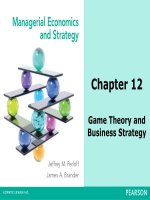Managerial economics strategy by m perloff and brander chapter 8competitive firms and markets
Bạn đang xem bản rút gọn của tài liệu. Xem và tải ngay bản đầy đủ của tài liệu tại đây (538.37 KB, 37 trang )
Chapter 8
Competitive Firms
and Markets
Table of Contents
•
•
•
•
8-2
8.1 Perfect Competition
8.2 Competition in the Short-Run
8.3 Competition in the Long-Run
8.4 Competition and Economic Well-being
© 2014 Pearson Education, Inc. All rights reserved.
Introduction
•
Managerial Problem
– In recent years, federal and state fees have increased substantially and
truckers have had to adhere to many new regulations.
– What effect do these new fixed costs have on the trucking industry’s
market price and quantity? Are individual firms providing more or fewer
trucking services? Does the number of firms in the market rise or fall?
•
Solution Approach
– We need to combine our understanding of demand curves with knowledge
about firm and market supply curves to predict industry price, quantity,
and profits.
•
Empirical Methods
– The relevant market structure is perfect competition where buyers and
sellers are price takers and firms have a horizontal demand.
– To maximize profit in the short run, the firm takes the price from the
market and with marginal cost determines its output.
– Firms have zero economic profit in the long run.
– Perfect competition maximizes economic well being of the society.
8-3
© 2014 Pearson Education, Inc. All rights reserved.
8.1 Perfect Competition
•
Characteristic # 1. Large Number of Buyers and Sellers
– If the sellers in a market are small and numerous, no single firm can raise
or lower the market price.
•
Characteristic # 2. Identical Products
– Buyers perceive firms sell identical or homogeneous products. Granny
Smith apples are identical, all farmers charge the same price.
•
Characteristic # 3. Full Information
– Buyers know the prices charged by all firms and that products are
identical. No single firm can unilaterally raise its price above the market
equilibrium price.
8-4
© 2014 Pearson Education, Inc. All rights reserved.
8.1 Perfect Competition
•
Characteristic # 4. Negligible Transaction Costs
– Buyers and sellers do not have to spend much time and money finding
each other or hiring lawyers to write contracts to make a trade.
– Perfectly competitive markets have very low transaction costs.
•
Characteristic # 5. Free Entry and Exit
– The ability of firms to enter and exit a market freely in the long run leads
to a large number of firms in a market and promotes price taking.
•
Example: The Chicago Commodity Exchange
– It has the 5 characteristics of perfect competition: many buyers and
sellers; they trade identical products; have full price information; waste no
time to make a trade; and anyone can be a buyer or seller.
8-5
© 2014 Pearson Education, Inc. All rights reserved.
8.1 Perfect Competition
•
Deviations from Perfect Competition
– Many markets possess some but not all of the
characteristics of perfect competition. But, buyers and
sellers are, for all practical purposes, price takers.
– Cities use zoning laws and fees to limit the number of
stores or motels, yet there are many sellers and all are
price takers.
– From now on, we will use the terms competition and
competitive to refer to all markets in which no buyer or
seller can significantly affect the market price—they are
price takers—even if the market is not perfectly
competitive.
8-6
© 2014 Pearson Education, Inc. All rights reserved.
8.2 Competition in the ShortRun
•
How Much to Produce
– From Chapter 7: to maximize profit find q where MR(q)=MC(q)
– A competitive firm has a horizontal demand, so MR=p
– A profit-maximizing competitive firm produces the amount of
output, q, at which p=MC(q)
•
Graphical Presentation
– In Figure 8.1, the market price of lime is p = $8 per metric ton
(horizontal demand). The MC curve crosses the horizontal
demand curve at point e where the firm’s output is 284 units.
– The π = $426,000, shaded rectangle in panel a. Panel b shows
that this is the maximum profit.
8-7
© 2014 Pearson Education, Inc. All rights reserved.
8.2 Competition in the ShortRun
Figure 8.1 How a
Competitive Firm
Maximizes Profit
8-8
© 2014 Pearson Education, Inc. All rights reserved.
8.2 Competition in the ShortRun
•
Whether to Produce
– Shutdown rule: R < VC (Chapter 7)
– Shutdown rule for a competitive firm: p < AVC = VC/q
•
Graphical Presentation of Shutdown Decision
– Price above AC: In Figure 8.2 price above a, positive profit.
– Price between min AVC and min AC: In Figure 8.2, the competitive
firm still operates if price between a and b.
– In Figure 8.2, the competitive firm shuts down if market price is
below a.
8-9
© 2014 Pearson Education, Inc. All rights reserved.
8.2 Competition in the ShortRun
Figure 8.2 The Short-Run Shutdown Decision
8-10
© 2014 Pearson Education, Inc. All rights reserved.
8.2 Competition in the Short-Run
•
Short-Run Firm Supply Curve
– A competitive firm chooses its output to maximize profit or
minimize losses when p = MC(q).
•
Graphical Presentation
– In Figure 8.3 the market price increases from p1 = $5 to p2 = $6 to
p3 = $7 to p4 = $8. The respective profit-maximizing outputs are
e1 through e4.
– As the market price increases, the equilibria trace out the
marginal cost curve.
– Competitive firm’s short-run supply curve: marginal cost curve
above its minimum average variable cost (red line)
8-11
© 2014 Pearson Education, Inc. All rights reserved.
8.2 Competition in the Short-Run
Figure 8.3 How the Profit-Maximizing
Quantity Varies with Price
8-12
© 2014 Pearson Education, Inc. All rights reserved.
8.2 Competition in the Short-Run
•
The Short-Run Market Supply Curve
– Market supply curve: horizontal sum of the supply curves of all
the individual firms in the market.
•
Graphical Presentation
– In the short run, the maximum number of firms in a market, n, is
fixed. In panel a of Figure 8.4, there is one firm and in panel b,
there are 4 firms identical to the one in panel a.
– If all firms are identical, each firm’s costs are identical, supply
curves are identical. The market supply at any price is n times the
supply of an individual firm; flatter. In panel b of Figure 8.4, S5 is
the market supply of 4 identical firms.
– If the firms have different costs functions, their supply curves and
shutdown points differ. Figure 8.5 in the textbook shows this
market supply; flatter.
8-13
© 2014 Pearson Education, Inc. All rights reserved.
8.2 Competition in the Short-Run
Figure 8.4 Short-Run Market Supply with Five
Identical Lime Firms
8-14
© 2014 Pearson Education, Inc. All rights reserved.
8.2 Competition in the Short-Run
•
Short-Run Competitive Equilibrium
– By combining the short-run market supply curve and the market demand
curve, we can determine the short-run competitive equilibrium.
•
Graphical Presentation
– Suppose that there are five identical firms in the lime manufacturing
industry. Panel a of Figure 8.6 shows the short-run cost curves and the
supply curve, S1, for a typical firm, and panel b shows the corresponding
short-run competitive market supply curve, S.
– If the market demand curve is D1, then the short-run equilibrium is E1, the
market price is $7, and market output is Q1 = 1,075 units (panel a). Each
firm takes the market price, maximizes profit at e1, and no firm wants to
change its behavior, so e1 is the firm’s equilibrium.
– If the demand curve shifts to D2, the market equilibrium is p = $5 and Q2 =
250 units (panel a). At that price, each firm produces q = 50 units and
loses $98,500, area A + C. However, they do not shut down.
8-15
© 2014 Pearson Education, Inc. All rights reserved.
8.2 Competition in the Short-Run
Figure 8.6 Short-Run Competitive Equilibrium
in the Lime Market
8-16
© 2014 Pearson Education, Inc. All rights reserved.
8.3 Competition in the Long-Run
•
Long-Run Competitive Profit Maximization
– Objective: Firms want to maximize long run profit and all costs are variable
or avoidable.
•
Decision 1: How Much to Produce
– To maximize profit or minimize a loss, firm operates where long-run
marginal profit is zero―where MR (price) equals long-run MC.
•
Decision 2: Whether to Produce
– After determining the output level, q*, the firm shuts down if its revenue is
less than its avoidable cost (all costs). So, it shuts down if it would make
an economic loss by operating.
8-17
© 2014 Pearson Education, Inc. All rights reserved.
8.3 Competition in the Long-Run
•
The Long-Run Firm Supply Curve
– The competitive market supply curve is the horizontal sum of the
supply curves of the individual firms.
– However in the long run, firms can enter or leave the market.
– Thus, before the horizontal sum, we need to determine how many
firms are in the market at each possible market price.
•
Free Entry and Exit
– In the long run, each firm decides whether to enter or exit
depending on whether it can make a long-run profit.
– In perfectly competitive markets, firms can enter and exit freely in
the long run.
– A shift of the market demand curve to the right attracts firms to
enter the market (π > 0) until the last firm to enter makes zero long
run profit.
– A shift of the market demand curve to the left forces firms to exit the
market (π < 0) until the last firm to exit makes zero long run profit.
8-18
© 2014 Pearson Education, Inc. All rights reserved.
8.3 Competition in the Long-Run
•
Long-Run Market Supply: Identical Firms & Free Entry
– The long-run market supply curve is flat at the minimum of longrun average cost if firms can freely enter and exit the market, an
unlimited number of firms have identical costs, and input prices
are constant.
•
Graphical Presentation
– In Figure 8.7, panel a, the individual supply starts at the minimum
long run average cost ($10) and each firm produces 150 units.
The market supply curve is horizontal at $10 (panel b), n firms will
produce 150n units.
8-19
© 2014 Pearson Education, Inc. All rights reserved.
8.3 Competition in the Long-Run
Figure 8.7 Long-Run Firm and Market Supply
with Identical Vegetable Oil Firms
8-20
© 2014 Pearson Education, Inc. All rights reserved.
8.3 Competition in the Long-Run
•
Long-Run Market Supply: Entry is Limited
– When entry is limited, long-run market supply curves slope
upward (horizontal sum of few individual supply curves).
– The number of firms is limited because of government
restrictions, resource scarcity, or high entry cost.
•
Long-Run Market Supply: Firms Differ
– When firms are not identical, long-run market supply
curves slope upward.
– Firms with relatively low minimum long-run average costs
are willing to enter the market at lower prices than others.
– Low cost firms cannot dominate the market because of
their limited capacity.
8-21
© 2014 Pearson Education, Inc. All rights reserved.
8.3 Competition in the Long-Run
•
Long-Run Competitive Equilibrium
– Equilibrium at the intersection of the long-run market supply and
demand curves
– With identical firms, constant input prices, free entry/exit:
equilibrium price equals minimum long-run average cost.
– A shift in the demand curve affects only the equilibrium quantity
and not the equilibrium price.
•
Short-Run and Long-Run Equilibrium Comparison
– In the short run, if the demand is as low as D1, the market price in
the short-run equilibrium, F1, is $7 (Figure 8.8). At that price,
individual firms lose money and some exit in the long run. In the
long-run equilibrium, E1, price is $10, and each firm produces 150
units, e, and breaks even.
– If demand expands to D2, in the short run, firms make profits at
F2. These profits attract entry in the long run, quantity increase
and price falls, E2.
8-22
© 2014 Pearson Education, Inc. All rights reserved.
8.3 Long Run Competitive
Equilibrium
Figure 8.8 The Short-Run and Long-Run
Equilibria for Vegetable Oil
8-23
© 2014 Pearson Education, Inc. All rights reserved.
8.3 Competition in the Long-Run
Zero Long-Run Profit with Free Entry
•
•
•
8-24
The long-run supply curve is horizontal if firms are free to enter the market, firms have
identical cost, and input prices are constant. All firms in the market are operating at
minimum long-run average cost (cost efficient).
That is, they are indifferent between shutting down or not because they are earning zero
economic profit
Any firm that does not maximize profit loses money. So, to survive in a competitive
market in the long run, a firm must maximize its profit (P=MC and be cost efficient).
© 2014 Pearson Education, Inc. All rights reserved.
8.4 Competition & Economic
Well-being
Why do we study competition in a book on managerial economics?
•
First
– Many sectors of the economy are highly competitive including agriculture,
parts of the construction industry, many labor markets, and much retail
and wholesale trade.
•
Second
– Perfect competition serves as an ideal or benchmark for other industries.
– Most important theoretical result in economics: a perfectly competitive
market maximizes an important measure of economic well-being
(consumer surplus, producer surplus and total surplus).
– Government intervention in a perfectly competitive market reduces a
society’s economic well-being. However, it may increase economic wellbeing in non-competitive markets, such as in a monopoly.
8-25
© 2014 Pearson Education, Inc. All rights reserved.









